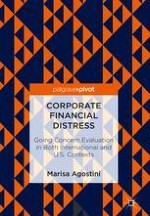2018 | OriginalPaper | Chapter
3. Going Concern Evaluation in the US Context: The Respective Roles of Auditors and Managers
Author : Marisa Agostini
Published in: Corporate Financial Distress
Publisher: Springer International Publishing
Activate our intelligent search to find suitable subject content or patents.
Select sections of text to find matching patents with Artificial Intelligence. powered by
Select sections of text to find additional relevant content using AI-assisted search. powered by
